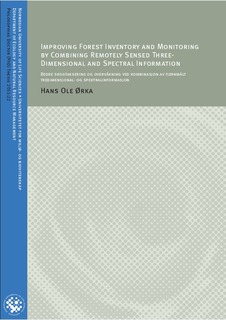| dc.contributor.advisor | Næsset, Erik | |
| dc.contributor.advisor | Gobakken, Terje | |
| dc.contributor.advisor | Bollandsås, Ole Martin | |
| dc.contributor.author | Ørka, Hans Ole | |
| dc.date.accessioned | 2017-03-08T16:35:15Z | |
| dc.date.available | 2017-03-08T16:35:15Z | |
| dc.date.issued | 2011 | |
| dc.identifier.isbn | 978-82-575-0986-6 | |
| dc.identifier.isbn | 978-82-575-0986-6 | |
| dc.identifier.issn | 1503-1667 | |
| dc.identifier.issn | 1503-1667 | |
| dc.identifier.uri | http://hdl.handle.net/11250/2433315 | |
| dc.description.abstract | Forest inventory has benefited from remote sensing for more than 80 years. Spectral information from aerial cameras has been the dominant data source during this period. However, over the past decade the use of three-dimensional data from airborne laser scanning (ALS) has substantially improved the accuracy of forest inventory, although there currently seems to be certain limitations for ALS in terms of providing tree species information, wallto-wall maps in large area inventory and multi-temporal acquisitions in forest monitoring. In all of these cases, spectral information may be complementary to three-dimensional information, and the combination of the two data sources may improve both forest inventory and monitoring. In this thesis, the potential for combining three-dimensional data from ALS and spectral information recorded by ALS (intensity), as well as multispectral aerial cameras and satellite sensors, was investigated. This thesis focuses on tree species identification, delineation of the subalpine zone and the quantifying effects of sensors and seasons in multitemporal acquisitions. Improvement in the accuracy of tree species identification was obtained in relation to both intensity and spectral information from aerial imagery. Aerial imagery seems to be a more stable spectral data source for tree species identification compared to intensity. A correct species identification for 85 – 90% of the dominant trees seems within reach. Moreover, it was revealed that both the three-dimensional and spectral information from ALS were affected by the sensor used and the season of data acquisition. At the moment, calibration with contemporary field measurements is needed for individual acquisitions. Estimates of individual tree height and stem diameter can be accurately derived for all multi-temporal acquisitions when calibrated with field data. Tree species identification was significantly better under leaf-off than leaf-on canopy conditions, but did not differ between sensors. Furthermore, a sample of three-dimensional data covering 8.4% of Hedmark County, Norway, was combined with full coverage Landsat imagery to help delineate the subalpine zone. The delineation of the subalpine zone boundaries was found to be accurate. Combining three-dimensional and spectral information may improve forest inventory and monitoring in many circumstances, although challenges and costs are increased by using multiple data sources and must be compared against the advantage of the higher information level obtained. | nb_NO |
| dc.language.iso | eng | nb_NO |
| dc.publisher | Norwegian University of Life Sciences, Ås | nb_NO |
| dc.relation.ispartofseries | PhD Thesis;2011:22 | |
| dc.rights | Attribution-NonCommercial-NoDerivatives 4.0 Internasjonal | * |
| dc.rights.uri | http://creativecommons.org/licenses/by-nc-nd/4.0/deed.no | * |
| dc.title | Improving forest inventory and monitoring by combining remotely sensed three-dimensional and spectral information | nb_NO |
| dc.title.alternative | Bedre skogtaksering og overvåkning ved kombinasjon av fjernmålt tredimensjonal- og spektralinformasjon | nb_NO |
| dc.type | Doctoral thesis | nb_NO |
| dc.subject.nsi | VDP::Agriculture and fishery disciplines: 900::Agriculture disciplines: 910::Forestry: 915 | nb_NO |
| dc.source.pagenumber | 1 b. (flere pag.) | nb_NO |

